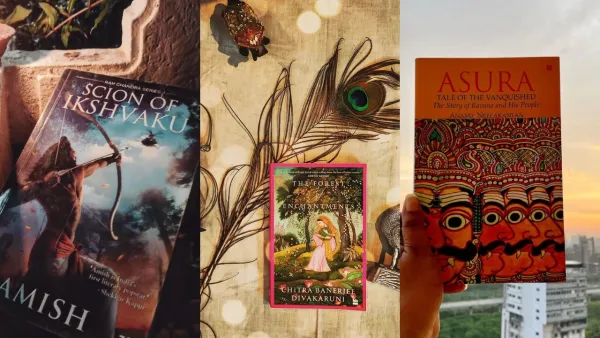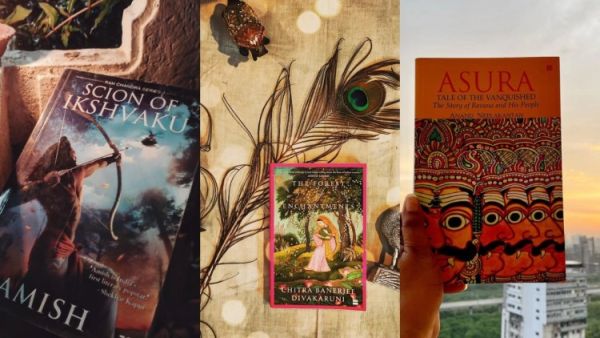
One of the most venerated characters in Indian mythology, Lord Ram, has endured as a representation of leadership, morality, and virtue that cuts beyond both religion and literature. His tale, which Valmiki immortalized in the epic “Ramayana,” has been repeated many times in a variety of ways, each with its own interpretation. Lord Ram’s persona has changed from the ancient texts to modern retellings, mirroring the shifting attitudes and ideals of society.

We explore the many writers who have rewritten the classic narrative of Lord Ram throughout the ages, adding fresh perspectives while preserving the core of his values.
1. The Ramayana by Valmiki: The First Epic
‘Ramayana’ by Valmiki is the earliest and most reliable story of Lord Ram’s life. This ancient Sanskrit literature portrays Ram as the pinnacle of dharma (goodness), a monarch who puts his responsibilities as a protector and ruler ahead of his own pleasures. According to Valmiki, Lord Ram is an incarnation of Vishnu who was created to purge the universe of evil, which is symbolized by Ravana, the Lankan demon king. His character is centered on his unshakable dedication to dharma, even at considerable personal sacrifice.
Ram’s celestial beginnings and his perfect traits as a king, spouse, son, and brother are highlighted in Valmiki’s depiction of him. The ‘Ramayana’ also presents important figures such as Sita, Lakshman, and Hanuman, whose dedication to Ram and commitment to him emphasize the ideals of service, sacrifice, and faith.
2. Ramcharitmanas by Tulsidas: A Devotional Viewpoint
Tulsidas penned the ‘Ramcharitmanas’ in the 16th century in the local dialect of Awadhi, which made the Ram narrative more widely known. The retelling by Tulsidas emphasizes Ram as the ultimate being and the personification of heavenly love and devotion, while Valmiki’s ‘Ramayana’ presents Ram as a celestial hero.
Ram in Tulsidas is revered as a god for his compassion, generosity, and grace, in addition to being a model monarch. His ‘Ramcharitmanas’ focuses on the bhakti (devotion) element, where the bond between Lord Ram and his followers—Hanuman and Bharat, among others—stands out. Because of its lyrical beauty and focus on devotion, Tulsidas’ version is still the most beloved story for many people, particularly in northern India.
3. Kamban’s Kamba Ramayanam: A Retelling from the South
The poet Kamban wrote “Kamba Ramayanam,” a Tamil adaptation of the “Ramayana,” in the twelfth century. The epic gains a regional flavor from Kamban’s adaptation, which also presents Ram as a sympathetic and relatable hero. In contrast to Valmiki’s depiction of Ram as a devout adherent of dharma, Kamban’s Ram is more approachable, exhibiting feelings like love, grief, and uncertainty.
Many of the characters, especially Sita and Hanuman, gain depth via Kamban’s storytelling, which also helps the reader identify with Ram’s hardships. The narrative highlights Ram’s humanity by showing him as a man who struggles with emotions and moral quandaries in addition to being an incarnation of Vishnu.
4. Modern Interpretations: The Ram Chandra Series by Amish Tripathi
The narrative of Lord Ram has also been reinterpreted in large part by contemporary writers. The ‘Ram Chandra Series’ by Amish Tripathi, one of India’s most well-known modern writers, presents a new interpretation of the ‘Ramayana’. By giving well-known characters in-depth backstories and delving into the political and social environments in which they lived, Tripathi transforms the epic into historical fiction.
Ram is shown in Tripathi’s adaptation as a strategic, orderly leader who is fervently committed to establishing a fair society. Ram is portrayed in the series as more imperfect and human, which helps readers now identify with him. The moral conundrums that contemporary leaders confront are reflected in Tripathi’s story, which also explores difficult moral issues, including whether the goals outweigh the methods.
5. Asura: Tale of the Vanquished by Anand Neelakantan
By narrating the “Ramayana” from Ravana’s point of view, Anand Neelakantan flips the conventional narrative in “Asura: Tale of the Vanquished.” Neelakantan shows Ravana as a complicated and misunderstood figure rather than as a monster, giving him a sympathetic portrayal. By doing this, the book offers a new interpretation of Ram, who the Asuras see as an invader and conqueror.
This reading of the ‘Ramayana’ challenges readers’ preconceived notions of hero and villain by posing significant questions about justice, power, and morality. As an example of how perspective affects our perception of right and evil, Neelakantan’s Ram is a good guy whose deeds are seen differently by those he opposes.
6. Chitra Banerjee Divakaruni’s Feminist Views: The Forest of Enchantments
‘The Forest of Enchantments’ by Chitra Banerjee Divakaruni is a feminist version of the ‘Ramayana’ that centers on Sita’s viewpoint. While the conventional stories often highlight Ram’s merits, Divakaruni’s book delves into Sita’s emotional and psychological journey, illuminating her inner strength and challenges.
This version sees Ram’s actions—especially his choice to banish Sita—through the eyes of a lady torn between her obligation as a queen and her love for her husband. A more complex and sympathetic picture of Ram is given by Divakaruni, who both praises and critiques his decisions.
7. Worldwide Interpretations: Southeast Asian Ram
India is not the only Southeast Asian civilization to have adopted the Ram myth; Thailand, Indonesia, and Cambodia are just a few examples. “Ramakien,” a Thai adaptation of the “Ramayana,” is ingrained in the nation’s artistic and cultural heritage. The Thai adaptation adds new characters and modifies certain elements to match the values and aesthetics of the area, but the primary plot stays the same.
The ‘Ramayana’ is enacted as a dance-drama in Indonesia, especially on the island of Bali, where Ram is considered a cultural hero. These many interpretations of Ram demonstrate how his tale has crossed national borders to represent virtue, leadership, and justice in a range of cultural situations.
Because of its universal themes of responsibility, sacrifice, and moral integrity, as well as its religious importance, Lord Ram’s narrative has persisted for generations. His persona has been interpreted in a variety of ways by ancient and contemporary writers, reflecting shifting societal norms and viewpoints. Both authors and viewers are still motivated by the ‘Ramayana’, from Valmiki’s depiction of the heavenly hero to Divakaruni’s sympathetic depiction of Ram through Sita’s eyes.